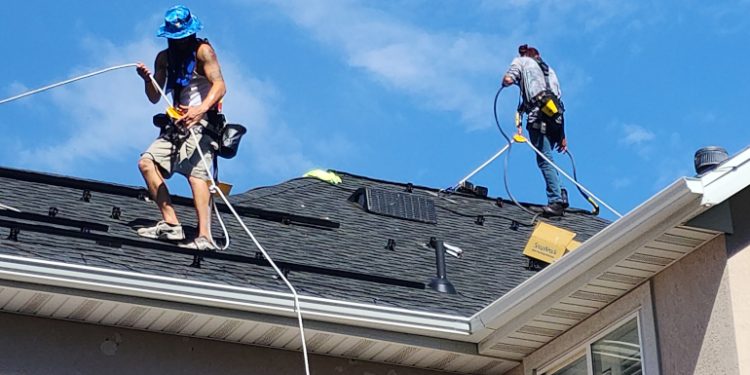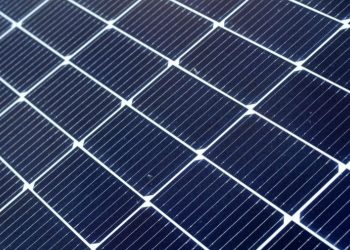Solar Power World has dedicated its March 2024 coverage to installation tips for solar contractors big and small. You can read the rest of our Q&As in the magazine and online here.
For insight into the “safety and wearables” segment, SPW talked with Kevin King, president of Solar Tools USA, to learn more about proper safety harness selection and the various installation accessories helping keep residential installers safe on rooftops.
What are the essential requirements for fall safety equipment when working on roofs as a solar installer?
Engaging in roof work as a solar installer poses unique challenges that conventional fall protection equipment may not adequately address. Traditional fall protection harnesses, primarily designed with a back connection point (dorsal ring), can be impractical and potentially unsafe for solar installers, who spend a significant amount of time facing the roof.
Some fall arrest harnesses can also come equipped with side D-rings and/or a chest D-ring (sternal ring), but it’s crucial to note that the side D-ring connection points are not approved for fall-arrest-use and are intended to be used only for positioning work. As for the chest D-ring, the sternal connection, there are only a few harnesses on the market that are rated for fall-arrest-use as long as you’re limiting your free fall distance to 2 ft or less by using the correct fall arrest system.
Furthermore, the manual manipulation of fall arresters and ropes can be cumbersome for solar installers who often navigate roofs with their hands full. It is important to recognize that not all fall protection gear is tailored to the needs of solar installers and the commonly used “compliance in a can” or standard fall protection kit may not be suitable for this specialized work.
Based on the testing and analysis of Solar Tools USA, the best fall protection equipment to use for optimal user experience ensures both maneuverability and legal compliance, and certain key components are indispensable for a solar installer’s fall protection kit. Here is a detailed list:
Harness: A sternal attachment rated for fall arrest is essential, featuring a chest ring designed to legally connect a lifeline and fall arrester. Opt for a lightweight, flexible and comfortable harness without a waist belt to facilitate unrestricted movement. Avoid mating buckles, as they can be challenging to manipulate with gloves. Look for harnesses with quick-connect locking systems.
Fall arrest system: Opt for a hands-free fall arrest system to allow for the carrying of solar panels and equipment. The fall arrester should smoothly slide up and down the rope, engaging promptly in the event of a fall. Ensure the fall arrester is accompanied by a shock absorber to minimize stress on the individual in case of a fall.
Thin, lightweight rope/lifeline: Choose a thin and lightweight rope or lifeline that complements the hands-free fall arrester.
Roof anchor: A secure and reliable roof anchor is crucial to providing a stable connection point for the fall protection system. By utilizing a fall protection kit specifically designed for solar installers, you can enhance both the accuracy and frequency of usage, ensuring a safer and more efficient working environment for you and your team.
How can contractors make their time on ladders safer?
 Contractors can enhance ladder safety by prioritizing the secure attachment of ladders to structures. The absence of this straightforward practice often leads to accidents on job sites. Contrary to common belief, ensuring ladder safety is not a time-consuming task, thanks to simple and efficient products designed to secure ladders without penetrating the structure.
Contractors can enhance ladder safety by prioritizing the secure attachment of ladders to structures. The absence of this straightforward practice often leads to accidents on job sites. Contrary to common belief, ensuring ladder safety is not a time-consuming task, thanks to simple and efficient products designed to secure ladders without penetrating the structure.
Given the diverse nature of jobsites and the varying challenges posed by architectural or structural differences, here is a list of ladder stabilizers with specific functions tailored to different structural designs:
Roof standoffs – bull horns:
- Designed for enhanced stability on pitched roofs, these standoffs support the ladder with a wide span and feet arched to the structure, resembling bull horns.
- While effective, they may be challenging to maneuver when attached to the ladder and can be somewhat restrictive.
- Prevents horizontal movement but does not restrict vertical movement.
Gutter clamp ladder stabilizers:
- Engineered to attach to any gutter, these stabilizers swiftly and securely lock the ladder to the structure without the need for tools.
- Fast and simple to use, preventing both horizontal and vertical movement.
Soffit ladder clamp:
- This ladder stability anchor is user-friendly and requires no tools. It is secured to a facia board or another horizontal structural member.
- The straps are wrapped around the ladder rung, providing stability by preventing both horizontal and vertical movement.
Ladder safety legs:
- Distinguishing itself with a unique design, this method focuses on the bottom of the ladder rather than the top.
- Enables easy maneuvering of the ladder and eliminates struggles with top-heaviness, allowing for adjustments on uneven terrain.
- Each leg is independently adjustable for added flexibility.
By incorporating these specialized ladder stabilizers based on the specific challenges presented by different structural designs, contractors can significantly improve ladder safety on job sites. This not only ensures the well-being of installers but also streamlines the process without compromising efficiency.
What does Solar Tools USA offer that is specifically made for solar installation?
Solar Tools USA emerged from the frustration stemming from the limited availability of specialized tools tailored to the unique needs of the solar industry. We firmly believe that every trade deserves access to tools that not only enhance efficiency but also prioritize safety. Why should solar installations be an exception?
Our mission is to address these challenges head-on and provide innovative solutions, and we are dedicated to alleviating the hurdles faced by installers by offering a comprehensive range of tools designed to streamline the solar installation process. Our website is meticulously crafted with the purpose of being a one-stop destination for all your solar installation tool requirements – whether you’re seeking essential tools or discovering solutions you didn’t know you needed.
Every product in our catalog has undergone a rigorous design and testing process, benefiting from the insights and approval of some of the finest professionals in the solar industry. This ensures that we are not just providing tools; we are offering solutions crafted by individuals who comprehend the intricacies of the solar industry.
Our goal is to empower installers with the right tools, making your work faster, safer and easier, ultimately contributing to the success of solar installations.
Some of the tools we have personally created for solar installers include solar panel carrying tools, the solar panel caddy, mod mover, solar panel hanger, solar spacer and solar racking torque limiter.
How can a solar contractor safely carry modules and other hardware to the roof?
Ensuring the safe transportation of solar modules and hardware to the roof is a crucial consideration for solar contractors. Adhering to safety regulations, such as the three-points-of-contact rule when climbing a ladder, is essential. Carrying solar panels manually while climbing a ladder is not a feasible option due to safety concerns. However, for tools and equipment, backpacks provide a practical solution.
To overcome the challenges of transporting solar panels to the roof, solar contractors can opt for “laddervators” or solar panel hoists. These systems come with solar panel carriers and tool carriers designed to lift panels and equipment to the roof, eliminating the need for manual carrying. In recent years, these products have evolved to be battery-operated, enhancing ease of use, and have become more cost-effective. While the initial investment may be higher than a standard ladder, the long-term benefits include a significant reduction in potential worker compensation claims or OSHA fines.
What advice would you give to someone building out their team’s solar safety plan?
Building out a comprehensive solar safety plan is essential to ensure a secure working environment. Here are some key pieces of advice to consider:
Prioritize safety: Emphasize a culture of safety within the team. Make it clear that safety is non-negotiable and that everyone has a role to play in maintaining a secure work environment.
Efficiency and safety go hand-in-hand: Dispel the misconception that safety slows down operations. Stress the idea that when the correct safety measures are in place, work can be completed faster, more efficiently, and with fewer disruptions.
Invest in quality equipment: Cheap or substandard safety equipment may lead to reluctance among team members to use it. Invest in high-quality safety gear that meets industry standards to ensure both compliance and the well-being of your team.
Understand the cost of non-compliance: Highlight the financial and operational consequences of OSHA fines. Emphasize that the cost of non-compliance can far exceed the investment in proper safety measures.
Training and education: Provide thorough training on the use of safety equipment and procedures. Regularly update the team on safety protocols and any changes in regulations. Ensure that everyone understands the importance of their role in maintaining safety.
Specialized tools and safety gear: Draw parallels between safety gear and specialized tools. Just as using the correct tool for a job enhances efficiency, using appropriate safety gear ensures a safer working environment. Stress that both are integral to successful and secure project completion.
Create a safety committee: Establish a safety committee within the team that includes representatives from various roles. This committee can actively contribute to the development, implementation, and improvement of safety protocols.
Encourage reporting and feedback: Foster an environment where team members feel comfortable reporting safety concerns and providing feedback on safety protocols. Act promptly on reported issues to show a commitment to continuous improvement.
Regular safety audits: Conduct regular safety audits to identify potential hazards and ensure compliance with safety protocols. This proactive approach helps in addressing issues before they escalate.
Celebrate safety milestones: Acknowledge and celebrate safety milestones. This can include achieving a certain number of accident-free days or successfully implementing new safety initiatives. Recognition reinforces the importance of a safety-first mindset.
Remember, a robust safety plan not only protects your team but also contributes to overall project success by minimizing accidents, reducing downtime, and promoting a positive work environment.




















